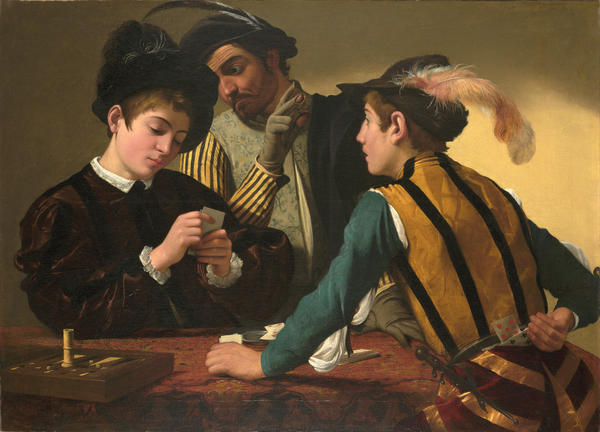
A man who sold a painting attributed to a follower of Caravaggio through Sotheby’s London in 2006 is suing the auction house for what he claims is a failure to recognize that the work was the real deal.
A relative of Lancelot Thwaytes bought The Cardsharps in 1962 for £140, reports the Independent. Half a century later, the family consigned the painting, which was purchased at Sotheby’s for £42,000 by Denis Mahon. Mahon then claimed it was an original Caravaggio worth in the region of £10 million.
The artwork pictures an innocent young man losing a game of cards against a couple of seasoned cheats. A similar painting was purchased by the Kimbell Art Museum, Forth Worth, Texas, in 1987.
An enlightened collector and leading art historian, Mahon is well known for reattributing several paintings to Caravaggio, including Dublin’s Christ taken into Captivity in 1992, a rediscovery described by the Times as “one of the most remarkable re-attributions of the century.”
Several other experts back Mahon’s most recent claim. According to Thwaytes, Vatican Museums director Antonio Paolucci and Mina Gregori, the president of Florence’s Fondazione di Studi di Storia dell’Arte Roberto Longhi, are among those who believe that the painting Mahon purchased is by Caravaggio. The seller is now accusing Sotheby’s of having failed to consult leading experts in the field ahead of the sale.
With the litigation ongoing, the auction house declined to comment when contacted by artnet News, but it nonetheless provided extracts of the document it submitted to court denying the accusations. It states that “the painting is not by Caravaggio” and is “clearly inferior in quality to the universally acknowledged original in the Kimbell Museum.”
Experts Disagree
While the papers provided say that the defendant “was entitled to rely solely on its own expert staff to research and catalogue the painting,” they nonetheless detail how the experts mentioned by Thwaytes are not qualified to have a view on the matter. The document concludes by putting forward another group of academics—including Professor Sebastian Schütze of the University of Vienna and Dr. Professor Sybille Ebert-Schifferer, director of the Bibliotheca Hertziana, Max Planck Institute, Rome─who share the view that the piece cannot be by Caravaggio.
Acting as the auction house’s “independent expert on attribution,” professor Richard Spear (author of Caravaggio and His Followers), Sotheby’s informed artnet News, will give evidence on November 7th and 10th.
Caravaggio died in murky circumstances in 1610, at 38 years old, in Porto Ercole, Tuscany (see “Caravaggio’s Remains Get Monumental Funerary Park”). At the time of his death, only 50 paintings were known to exist. They rarely go under the hammer.
Thwaytes’ expert Mina Gregori seems to have hit a lucky streak of late. The art historian also claims to have rediscovered a long-lost version of Caravaggio’s Mary Magdalene in Ecstasy in a European private collection (see “Caravaggio’s Mary Magdalene Found in Private Collection”).
The court is yet to set a date for ruling on the Thwaytes case.